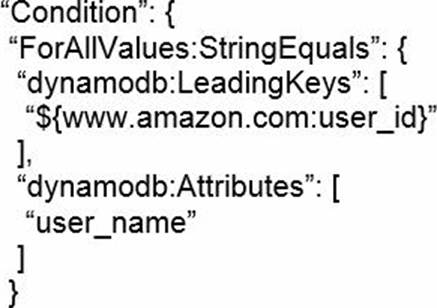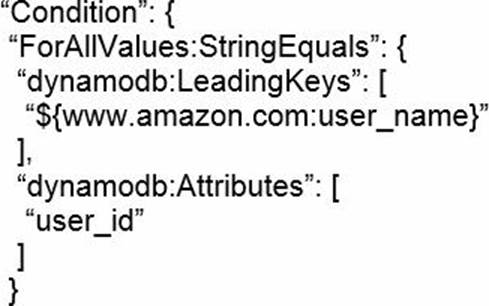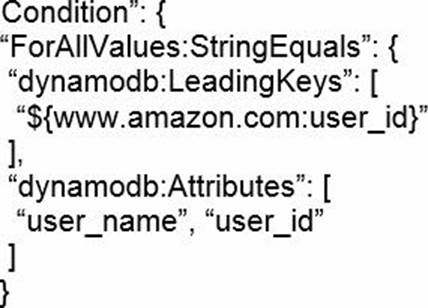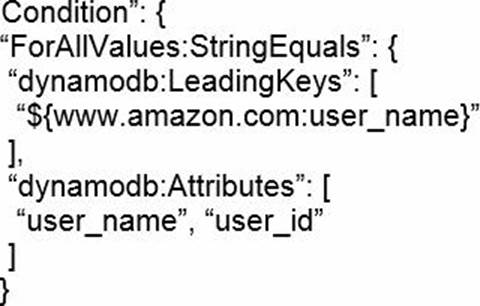Amazon DVA-C01 AWS Certified Developer – Associate Online Training
Amazon DVA-C01 Online Training
The questions for DVA-C01 were last updated at Jul 19,2025.
- Exam Code: DVA-C01
- Exam Name: AWS Certified Developer – Associate
- Certification Provider: Amazon
- Latest update: Jul 19,2025
An application is being developed to audit several AWS accounts. The application will run in Account A and must access AWS services in Accounts B and C.
What is the MOST secure way to allow the application to call AWS services in each audited account?
- A . Configure cross-account roles in each audited account. Write code in Account A that assumes those roles
- B . Use S3 cross-region replication to communicate among accounts, with Amazon S3 event notifications to trigger Lambda functions
- C . Deploy an application in each audited account with its own role. Have Account A authenticate with the application
- D . Create an IAM user with an access key in each audited account. Write code in Account A that uses those access keys
A developer wants to send multi-value headers to an AWS Lambda function that is registered as a target with an Application Load Balancer (ALB).
What should the developer do to achieve this?
- A . Place the Lambda function and target group in the same account
- B . Send the request body to the Lambda function with a size less than 1 MB 0
- C . Include the Base64 encoding status status code, status description, and headers in the Lambda function
- D . Enable the multi-value headers on the ALB
The development team is working on an API that will be served from Amazon API gateway. The API will be served from three environments: development, test, and production. The API Gateway is configured to use 237 GB of cache in all three stages.
Which is the MOST cost-efficient deployment strategy?
- A . Create a single API Gateway with all three stages.
- B . Create three API Gateways, one for each stage in a single AWS account.
- C . Create an API Gateway in three separate AWS accounts.
- D . Enable the cache for development and test environments only when needed.
An application is running on an EC2 instance. The Developer wants to store an application metric in Amazon CloudWatch.
What is the best practice for implementing this requirement?
- A . Use the PUT Object API call to send data to an S3 bucket. Use an event notification to invoke a Lambda function to publish data to CloudWatch.
- B . Publish the metric data to an Amazon Kinesis Stream using a PutRecord API call.
Subscribe a Lambda function that publishes data to CloudWatch. - C . Use the CloudWatch PutMetricData API call to submit a custom metric to CloudWatch.
Provide the required credentials to enable the API call. - D . Use the CloudWatch PutMetricData API call to submit a custom metric to CloudWatch.
Launch the EC2 instance with the required IAM role to enable the API call.
A Developer is making changes to a custom application that is currently using AWS Elastic Beanstalk.
After the Developer completes the changes, what solutions will update the Elastic Beanstalk environment with the new application version? (Choose two.)
- A . Package the application code into a .zip file, and upload, then deploy the packaged application from the AWS Management Console
- B . Package the application code into a .tar file, create a new application version from the AWS Management Console, then update the environment by using AWS CLI
- C . Package the application code into a .tar file, and upload and deploy the packaged application from the AWS Management Console
- D . Package the application code into a .zip file, create a new application version from the packaged application by using AWS CLI, then update the environment by using AWS CLI
- E . Package the application code into a .zip file, create a new application version from the AWS Management Console, then rebuild the environment by using AWS CLI
A gaming application stores scores for players in an Amazon DynamoDB table that has four attributes user_id, user_name, user_score, and user_rank. The users are allowed to update their names only A user is authenticated by web identity federation.
Which set of conditions should be added in the policy attached to the role for the dynamodb: PutItem API call?
A)

B)

C)

D)

- A . Option A
- B . Option B
- C . Option C
- D . Option D
A software company needs to make sure user-uploaded documents are securely stored in Amazon S3. The documents must be encrypted at rest in Amazon S3. The company does not want to manage the security infrastructure in-house, but the company still needs extra protection to ensure it has control over its encryption keys due to industry regulations.
Which encryption strategy should a developer use to meet these requirements?
- A . Server-side encryption with Amazon S3 managed keys (SSE-S3)
- B . Server-side encryption with customer-provided encryption keys (SSE-C)
- C . Server-side encryption with AWS KMS managed keys (SSE-KMS)
- D . Client-side encryption
A company’s ecommerce website is experiencing massive traffic spikes, which are causing performance problems in the company database. Users are reporting that accessing the website takes a long time.
A developer wants to implement a caching layer using Amazon ElastiCache. The website is required to be responsive no matter which product a user views, and the updates to product information and prices must be strongly consistent
- A . Which cache writing policy will satisfy these requirements?
- B . Write to the cache directly and sync the backend at a later time.
- C . Write to the backend first and wait for the cache to expire.
- D . Write to the cache and the backend at the same time
- E . Write to the backend first and invalidate the cache
A website’s page load times are gradually increasing as more users access the system at the same time. Analysis indicates that a user profile is being loaded from a database in all the web pages being visited by each user and this is increasing the database load and the page load latency. To address this issue the Developer decides to cache the user profile data.
Which caching strategy will address this situation MOST efficiently?
- A . Create a new Amazon EC2 Instance and run a NoSQL database on it. Cache the profile data within this database using the write-through caching strategy.
- B . Create an Amazon ElastiCache cluster to cache the user profile data. Use a cache-aside caching strategy.
- C . Use a dedicated Amazon RDS instance for caching profile data. Use a write-through caching strategy.
- D . Create an ElastiCache cluster to cache the user profile data. Use a write-through caching strategy.
How is provisioned throughput affected by the chosen consistency model when reading data from a DynamoDB table?
- A . Strongly consistent reads use the same amount of throughput as eventually consistent reads
- B . Strongly consistent reads use more throughput than eventually consistent reads.
- C . Strongly consistent reads use less throughput than eventually consistent reads
- D . Strongly consistent reads use variable throughput depending on read activity
Latest DVA-C01 Dumps Valid Version with 463 Q&As
Latest And Valid Q&A | Instant Download | Once Fail, Full Refund

